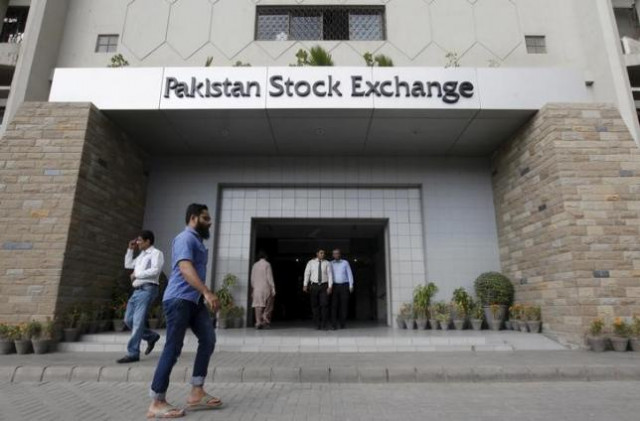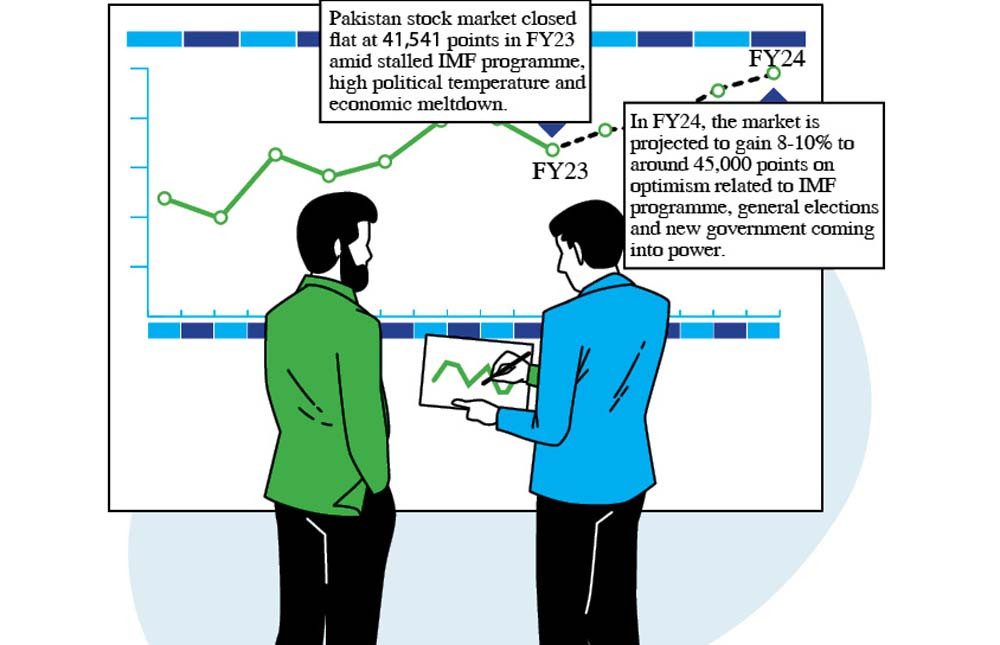PSX shows signs of recovery amidst economic struggles
Offsets losses to negligible 0.20% decline, closing at 41,453 points on Tuesday

Despite facing significant hurdles throughout the fiscal year 2023, the Pakistan Stock Exchange (PSX) managed to bounce back from a three-year low and close almost flat, instilling hope for a brighter future. The market, which serves as a barometer for the domestic economy, offset its losses to a negligible 0.20% decline, closing at 41,453 points on Tuesday. This impressive recovery came after a challenging previous fiscal year, during which the PSX lost 12% to reach 41,541 points.
In contrast to the previous fiscal year’s robust growth rate of 6.1%, Pakistan’s economy saw a modest expansion of 0.29% in FY23. Topline Research reported that the PSX posted gains in the last quarter (Apr-Jun) of FY23, breaking a streak of four consecutive quarters of losses caused by political upheaval, economic turbulence, and multiple suspensions and delays in the resumption of the stalled IMF loan program, worth $6.7 billion.
The PSX’s performance in FY23 suffered a blow in US dollar terms, recording a 29% loss primarily due to a historic 28% depreciation of the Pakistani rupee. Unfortunately, FY23 marked the seventh consecutive year of foreign selling at PSX, with outflows totalling $2.5 billion from 2016 to 2022.
Despite these challenges, experts see a glimmer of hope on the horizon. They anticipate a breakthrough in the long-awaited negotiations between Pakistan and the IMF, leading to the availability of a relatively smaller loan programme. This positive development, along with projections for the market to turn around in the upcoming fiscal year starting July 1, 2023, has instilled optimism among analysts.
Speaking to The Express Tribune, Tahir Abbas, Head of Research at Arif Habib Limited, expressed optimism saying, “PSX benchmark KSE 100 Index is expected to gain 20% and reach around 50,000 points in FY24.” AHL’s report highlighted the significance of monitoring upcoming events, including updates on the IMF programme, the completion of assembly tenures, general elections, and the government’s negotiation with the IMF.
Successful resumption of the IMF programme is expected to pave the way for inflows from other multilateral and bilateral partners, as well as friendly countries. This could bolster Pakistan’s foreign exchange reserves and alleviate pressure on the external front. Additionally, experts predict that the headline consumer price index (CPI) will start to taper off from June 2023 onwards, attributing this trend to the high base effect of the previous year. However, the future inflation outlook heavily depends on the successful revival of the IMF programme, the impact of budgetary measures, and effective debt repayment management. If these factors align, a bet can be placed on interest rate cuts one year down the line, thanks to lower inflation levels.
Despite economic headwinds, companies listed in the KSE100 index demonstrated resilience, posting a profitability growth of 8.8% during the first nine months of FY23. Looking ahead to FY24, earnings growth of 8.3% is expected, providing support for the index going forward. To navigate these uncertain times, the research house advises investors to select long-term stocks with strong fundamentals, including companies with US dollar revenue streams and leverage-free balance sheets with strong payouts. Sectors such as oil and gas exploration, banks, cement, fertiliser, and power are potential areas to explore.

design: Ibrahim Yahya
In terms of valuation, the KSE-100 is currently trading at a price-to-earnings ratio (PER) of 3.5 multiples (2023), significantly lower than the Asia Pacific regional average of 11.3 multiples. Furthermore, it offers a dividend yield of 11.7% compared to the region’s 3%.
PSX in FY2023
The PSX’s journey in FY23 was marked by significant fluctuations. The benchmark KSE 100-Index hit a three-year low of 38,136 points in January 2023, mainly due to delays in resuming the IMF loan programme. However, it reached an intra-year high of 43,888 points in August 2022 after the government signed a staff-level agreement (SLA) with the IMF for the third resumption of the programme. Average traded volume and value during FY23 experienced a substantial decline of 34% (192 million shares) and 54% ($25 million), respectively, year-on-year.
Negative contributors to the benchmark index during FY23 included pharmaceuticals (561 points), miscellaneous (435 points), automobile assemblers (310 points), refineries (159 points), and food (145 points). On the positive side, fertiliser (802 points), power (535 points), technology (357 points), cement (356 points), and chemicals (198 points) contributed to the index’s growth.
FY23 presented numerous economic challenges, including mounting external sector pressures, delays in the resumption of the IMF programme, a growing fiscal deficit, soaring inflation, and an 825-basis-point increase in the policy rate, reaching a historic high of 22%. These factors collectively made equities less attractive to investors.
Throughout FY23, the State Bank of Pakistan’s foreign exchange reserves witnessed a significant decline of $6.2 billion, reaching $3.5 billion by the end of the period. This decline resulted in a historical 28% depreciation of the Pakistani rupee against the US dollar, closing at Rs285.99/$ on the last working day of FY23.
Published in The Express Tribune, June 29th, 2023.
Like Business on Facebook, follow @TribuneBiz on Twitter to stay informed and join in the conversation.



















COMMENTS
Comments are moderated and generally will be posted if they are on-topic and not abusive.
For more information, please see our Comments FAQ